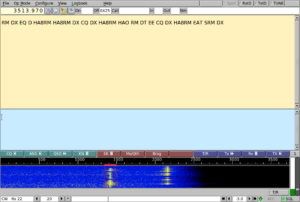

- #Fldigi and cw operation install#
- #Fldigi and cw operation archive#
- #Fldigi and cw operation download#
- #Fldigi and cw operation windows#
Once the CW reader engine has been selected, click on Save to save the selection and exit the Setup window. You set up the COM port communications parameters for the TNC in the bottom part of the window. The third supported CW reader type is an external TNC that is capable of decoding Morse code. You do not need to make a separate copy of CwGet outside the Program Files path. Unlike fldigi, CwGet may be run from the default installation location even if that location is in C:\Program Files or C:\Program Files(x86). It is also possible to select command line settings for CwGet in the setup window. In either case, after downloading and installing CwGet you can select it in the CW Reader setup window by checking the Enable check box for CW Get and entering the path to the program. The unregistered version does not save configuration information between runs, which means that you will have to perform the setup (primarily selection of the sound card to be used) each time the CwGet engine is started. It may be used either unregistered (free), or registered (requires a fee to be paid to the author). This is a shareware program that can be downloaded from the web site. The second supported CW reader program is CwGet by UA9OV. The first time it is run from the Logger, fldigi will create the other files it needs in the new location.
#Fldigi and cw operation install#
Simply install in the default location, create a new location outside the Program Files path, and copy the fldigi.exe file from the original installed location into the new location. When you first install fldigi, you do not need to do the original installation of fldigi outside the Program Files path.
#Fldigi and cw operation windows#
Although you can run fldigi stand-alone from a location in the Program Files path, any copy of fldigi that is run from N1MM Logger+ in Windows Vista or newer must not be located in a protected Program Files path. Both of these copies of fldigi should be outside the Program Files or Program Files(x86) paths in Windows Vista or later, in order to enable the configuration files to be saved. You may wish to use a separate copy of fldigi for CW from the N1MM+ digital modes copy as well that way, the configuration setups for fldigi for CW and for digital modes can be saved separately. You should create a separate folder for the fldigi CW reader and copy fldigi.exe from the main fldigi installation folder into this separate folder. Click on the Enable check box for Fldigi and set up the location of the fldigi.exe file you are using as a CW reader. Once fldigi has been downloaded (and optionally configured for digital mode operation – see the Digital – Fldigi for Sound Card Modes chapter), it can also be used as a receive-only CW reader (N1MM Logger+ does not support transmitting CW from fldigi).
#Fldigi and cw operation download#
Fldigi is not automatically installed with N1MM Logger+ if you want to use it, you must download and install it. The first, Fldigi by W1HKJ, is also one of the digital engines that is supported by the Logger for digital modes. N1MM Logger+ supports three different CW reader programs, or “engines”. The first time you open the CW Reader window, or any time the window is opened with no CW reader engine selected in the setup, the following dialog will be displayed:Īfter clicking on OK in the above window, or at any time thereafter by selecting the Setup menu in the main CW Reader window, the following setup window will be displayed:


The CW reader engine cannot be used to transmit CW to transmit CW, you must configure some other method in the Logger (serial or parallel port keying, or a Winkeyer, for example). Setup DX, DXpedition, and General Purpose Contests.Windows – Table of Contents View (long).Call History and Reverse Call History Lookup.
#Fldigi and cw operation archive#
Archive Files (1/2021) – N1MM on WindowsXP.


 0 kommentar(er)
0 kommentar(er)
